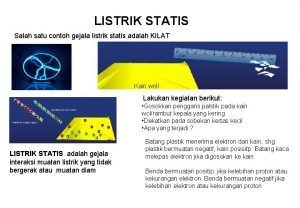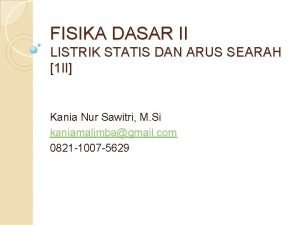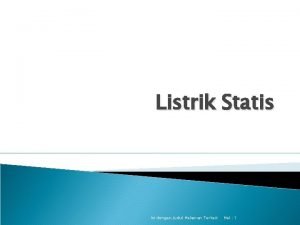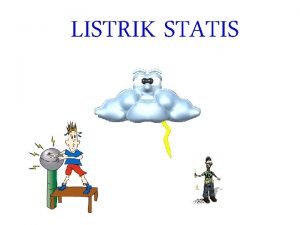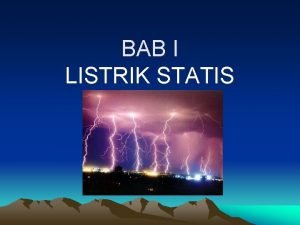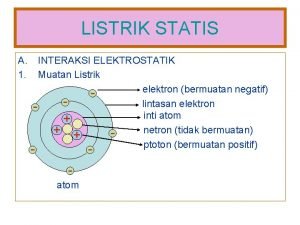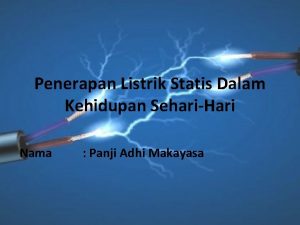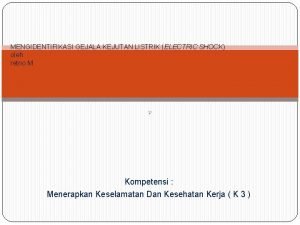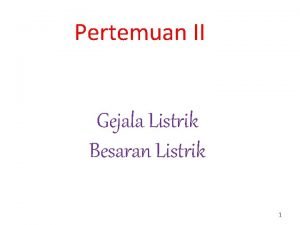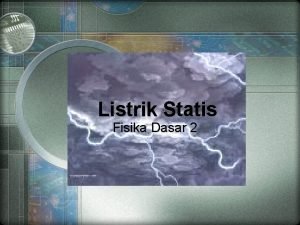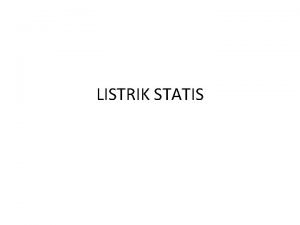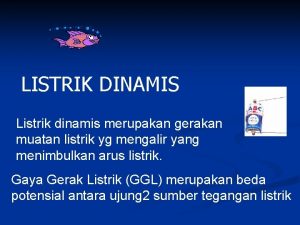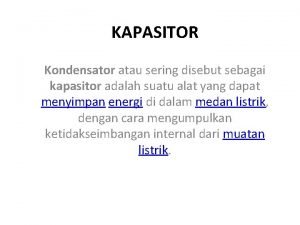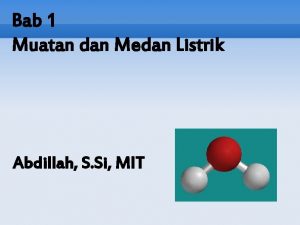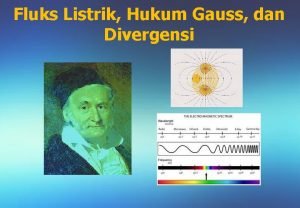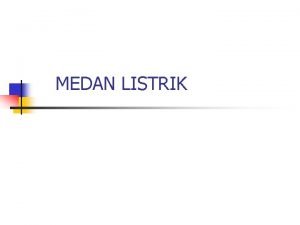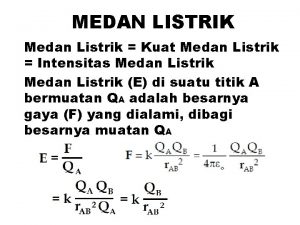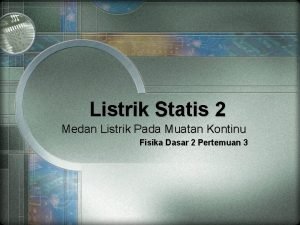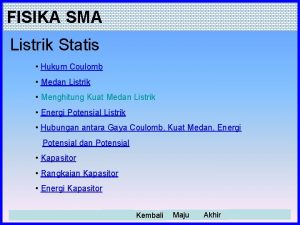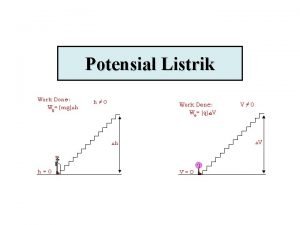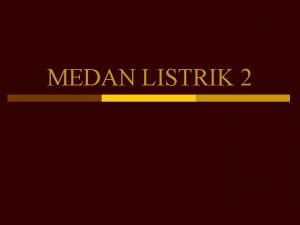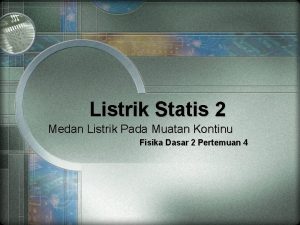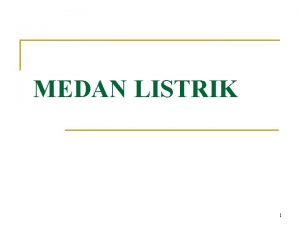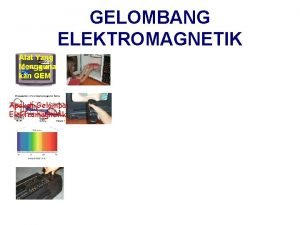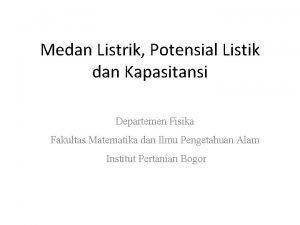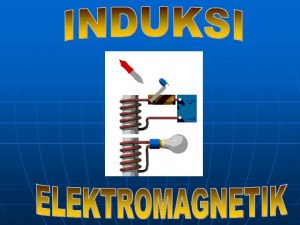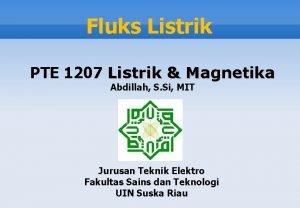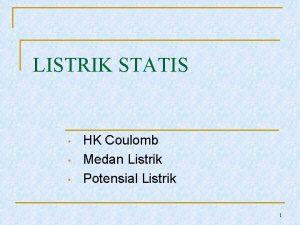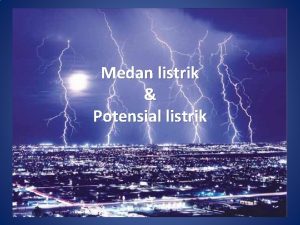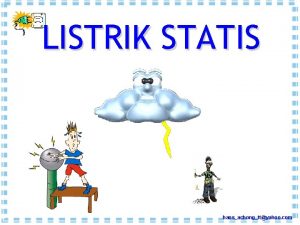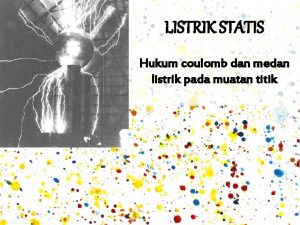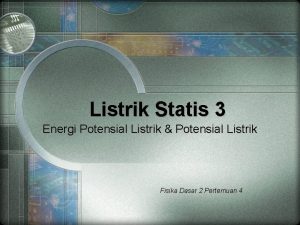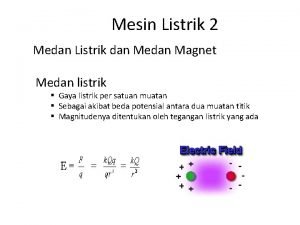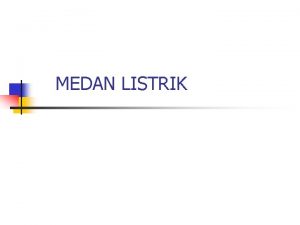Medan Listrik Statis II Material Kapasitansi Numerik Simulasi



































- Slides: 35

Medan Listrik Statis II (Material, Kapasitansi, Numerik Simulasi) Sukiswo sukiswok@yahoo. com Medan Elektromagnetik. Sukiswo 1

ELECTROSTATICS - MATERIALS Sukiswo, Medan Elektromagnetik

CONDUCTORS and DIELECTRICS Conductors Dielectrics High conductivities; s (for Copper) ~ 5. 8 x 107 S/m Low conductivities; s (for Rubber) ~ 1 x 10 -15 S/m or 1/W-m Semiconductors (mid s’s) Permittivities, e = 1 -100 e 0 Note: e 0 is the permittivity of free space/vacuum = 8. 854 x 10 -12 F/m Medan Elektromagnetik. Sukiswo 3

CONDUCTORS Most electrons are stuck to the nucleus But, 1 or 2 electrons per atom are free to move This means that if you apply an external Efield, the free electrons will move Lattice of Nuclei Medan Elektromagnetik. Sukiswo 4

CONDUCTORS - - electrons + + + + + conductor Apply external E-field, • Force on electrons causes free electrons to move • Charge displacement causes response E-field (opposite to applied external E-field) Medan Elektromagnetik. Sukiswo 5

CONDUCTORS The electrons keep moving until, This means that: , in a conductor Conductor is equipotential Medan Elektromagnetik. Sukiswo 6

DIELECTRICS electron cloud + + nucleus electron cloud centered on nucleus Cloud shifts to setup Medan Elektromagnetik. Sukiswo 7

DIELECTRICS Define: dipole moment Polarization partially cancels applied Field Medan Elektromagnetik. Sukiswo 8

DIELECTRICS subtracts out bound charge Define: Displacement Flux Density ( C/m 2 ) Electric Field (V/m) is due to bound/dielectric charge and free charge is due to bound/dielectric charge only and opposite sign is due to free charge only Medan Elektromagnetik. Sukiswo 9

FREE CHARGES Examples of free charges: rs on conductor electron beam doped region of semi-conductor Gauss’ Law uses just free charge Most general form Medan Elektromagnetik. Sukiswo 10

DIELECTRICS Don’t need to know about bound charges to find Many materials have Define , where Typically, Medan Elektromagnetik. Sukiswo 11

DIELECTRIC BREAKDOWN Example: Arc in Air If E-field is too large, it will pull electrons off from atom These electrons are accelerated by the E-field These accelerated electrons then collide with more atoms that knock off more electrons This is an AVALANCHE PROCESS Damages materials - there is a Voltage limit on components, cables in air : = 30 k. V/cm BREAKDOWN OCCURS if Medan Elektromagnetik. Sukiswo 12

BOUNDARY CONDITIONS - Normal Components • all derived from Maxwell’s equations NORMAL COMPONENT Take h << a a Material 1 Material 2 (a thin disc) TOP BOTTOM h Gaussian Surface Medan Elektromagnetik. Sukiswo 13

BOUNDARY CONDITIONS - Normal Components Case 1: Case 2: REGION 2 is a CONDUCTOR, D 2 = E 2 =0 REGIONS 1 & 2 are DIELECTRICS with rs = 0 Can only really get rs with conductors Medan Elektromagnetik. Sukiswo 14

BOUNDARY CONDITIONS - Tangential Components Material 1 w Material 2 h h << w Note: If region 2 is a conductor E 1 t = 0 Outside conductor E and D are normal to the surface Medan Elektromagnetik. Sukiswo 15

ELECTROSTATICS - CAPACITANCE Sukiswo, Medan Elektromagnetik

CAPACITANCE of Coaxial Cable In previous class, for coaxial cable: a Note: b inner conductor outer conductor Define: very general result charge on 1 conductor DV between conductors Note that: Medan Elektromagnetik. Sukiswo 17

Calculation of CAPACITANCE Problems on calculation of C Find Q 1. Method - Assume rs (use symmetry) Find V(rs) 2. Alternate method - Assume V and find Q Medan Elektromagnetik. Sukiswo 18

CAPACITANCE - parallel plate capacitor z=d Use Gauss’ Law, z=0 C of Parallel Plate capacitor Medan Elektromagnetik. Sukiswo 19

CAPACITANCE - parallel plate capacitor Parallel Plate Capacitance To get large C • increase A • increase e • decrease d This is how electrolytics increase C Do problem 1 a or 2 a & 2 b Medan Elektromagnetik. Sukiswo 20

CAPACITANCE - ENERGY METHOD • energy stored in capacitors is stored in the E-field Define stored energy: Substitute values of C and V for parallel plate capacitor: Energy Density Medan Elektromagnetik. Sukiswo Volume 21

CAPACITANCE - ENERGY METHOD In general we can write the total stored energy as: or Medan Elektromagnetik. Sukiswo 22

CAPACITANCE - ENERGY METHOD Use the Energy Formulation to compute C for the Parallel Plate Capacitor We know that, Compute TOTAL ENERGY: Medan Elektromagnetik. Sukiswo 23

CAPACITANCE Any 2 conductors have capacitance Example: • lines on circuit board • Theremin • wires and cables Medan Elektromagnetik. Sukiswo 24

ELECTROSTATICS - Numerical Simulation Sukiswo, Medan Elektromagnetik

Direct Computation of V If we can express entire problem in terms of V then: • we can solve directly for V • derive all other quantities e. g. E-field, D-field, C and r This approach can be used if conductor defines Outer Boundary • can be SYMMETRIC or NON-SYMMETRIC systems Why is this a useful approach? ? • V is a scalar field - easier to manipulate than E-field • We can control V on conductors • Can apply numerical methods to solve problem Medan Elektromagnetik. Sukiswo 26

Use of Laplace and Poisson’s Equations Start with 2 of MAXWELL’s equations: & In rectangular coordinates: Medan Elektromagnetik. Sukiswo 27

Use of Laplace and Poisson’s Equations Poisson’s equation: Laplace’s equation: (when r = 0) Medan Elektromagnetik. Sukiswo 28

Numerical Solution: Finite Difference Method Use the FINITE DIFFERENCE Technique for solving problems Solve for approximate V on the Grid - for 2 -D Problem Vtop h Vcenter Vleft Vright Vcenter at (x, y) = (0, 0) Vbottom h Medan Elektromagnetik. Sukiswo 29

Numerical Solution: Finite Difference Method At (x, y) = (h/2, 0) h Vtop h Vleft Vcenter Vright Vbottom At (x, y) = (-h/2, 0) Medan Elektromagnetik. Sukiswo 30

Numerical Solution: Finite Difference Method 0 Now, Can get similar expression for Medan Elektromagnetik. Sukiswo 31

Numerical Solution: Finite Difference Method Finally we obtain the following expression: Rearrange the equation to solve for Vcenter : Poisson Equation Solver Laplace Equation Solver Medan Elektromagnetik. Sukiswo 32

Numerical Solution: Example 100 V V 1 Solution Technique - by Iteration V 2 10 V 30 V V 3 V 4 Guess a solution : V=0 everywhere except boundaries V 1 = V 2 = V 3 = V 4 = 0 60 V Start: Put new values back Medan Elektromagnetik. Sukiswo 33

Numerical Solution - use of EXCEL Spreadsheet • To get an accurate solution, need lots of points - one way is to use a SPREADSHEET In spreadsheet, A 1 to A 31 set boundary voltage = 0 Volts Set these cells to 100 Copy B 2 formula to rest of cells A 31 Medan Elektromagnetik. Sukiswo 34

Numerical Solution: Problems 3 c. At point P, what is rs ? Get rs from Boundary Conditions: Approximate 3 d. Use spreadsheet to add columns: 3 e. Use C=Q/V Medan Elektromagnetik. Sukiswo 35
 Listrik statis dinamis
Listrik statis dinamis Conto gejala listrik statis
Conto gejala listrik statis Medan magnet statis
Medan magnet statis Tentukan kuat arus yang mengalir pada rangkaian
Tentukan kuat arus yang mengalir pada rangkaian Contoh gejala listrik statis
Contoh gejala listrik statis Listrik statis
Listrik statis Datastickies
Datastickies Sejarah penemuan listrik
Sejarah penemuan listrik V=kq/r
V=kq/r Penerapan listrik statis dalam kehidupan sehari-hari
Penerapan listrik statis dalam kehidupan sehari-hari Proses terjadinya listrik statis
Proses terjadinya listrik statis Ppt listrik statis kelas 9
Ppt listrik statis kelas 9 Sf6cb
Sf6cb Contoh gejala listrik dinamis
Contoh gejala listrik dinamis Fisika
Fisika Rumus luas penampang kawat
Rumus luas penampang kawat Elektrodinamis adalah
Elektrodinamis adalah Apa itu listrik dinamis
Apa itu listrik dinamis Jembatan pembanding kapasitansi
Jembatan pembanding kapasitansi Kondensator sering juga disebut
Kondensator sering juga disebut Sebuah partikel alpha (m=6 4x10
Sebuah partikel alpha (m=6 4x10 Contoh soal fluks listrik
Contoh soal fluks listrik Medan listrik
Medan listrik Pengertian kuat medan listrik
Pengertian kuat medan listrik Medan listrik muatan kontinu
Medan listrik muatan kontinu Gaya coulomb dengan permitivitas relatif
Gaya coulomb dengan permitivitas relatif Medan listrik
Medan listrik Medan listrik dipol
Medan listrik dipol Kuat medan listrik muatan kontinu
Kuat medan listrik muatan kontinu Asal kata magnet
Asal kata magnet Medan listrik
Medan listrik Urutan gelombang elektromagnetik
Urutan gelombang elektromagnetik Potensial listrik setengah lingkaran
Potensial listrik setengah lingkaran Arus listrik menimbulkan medan magnet
Arus listrik menimbulkan medan magnet Rumus fluks listrik
Rumus fluks listrik Intensitas listrik
Intensitas listrik

